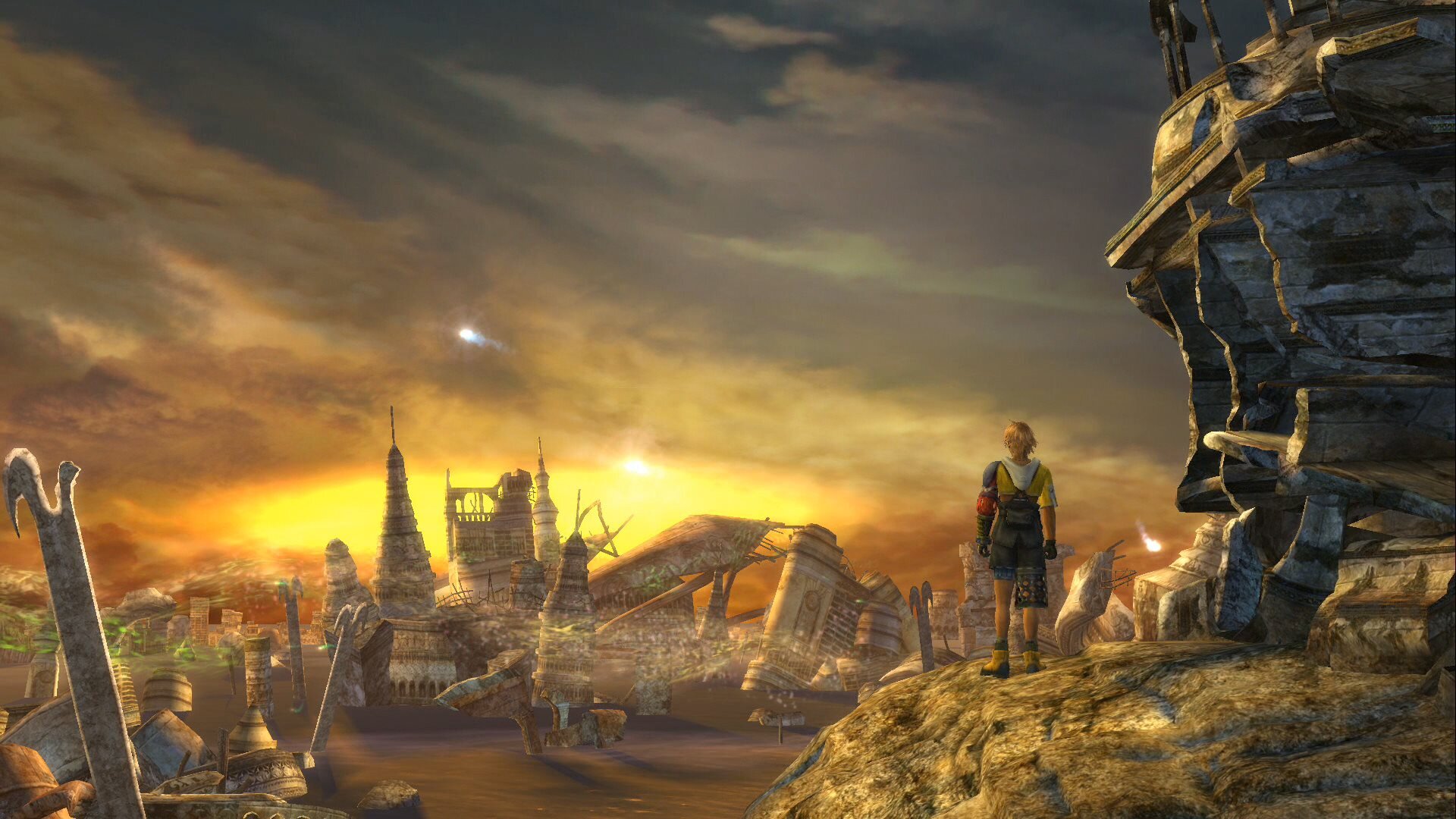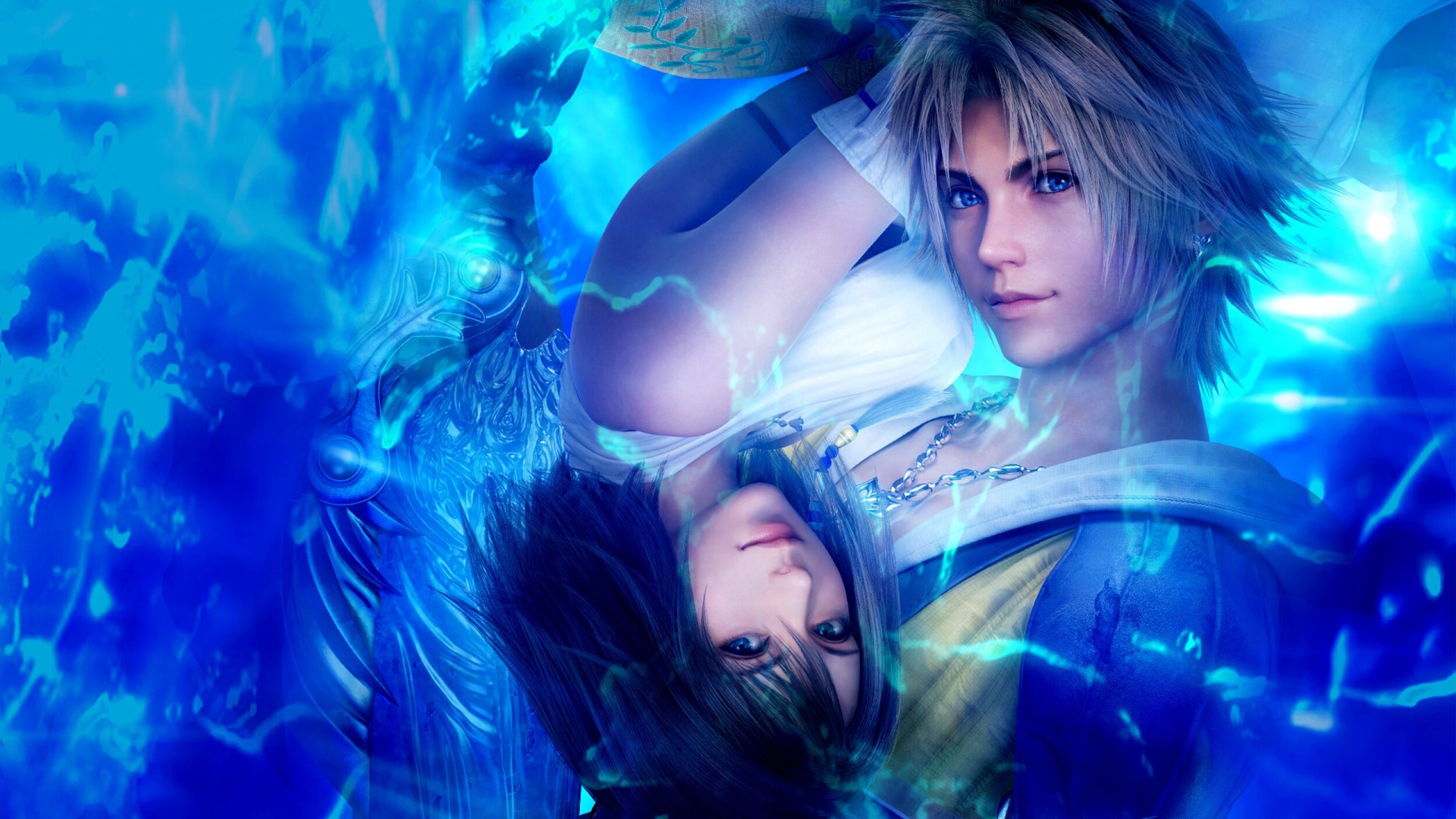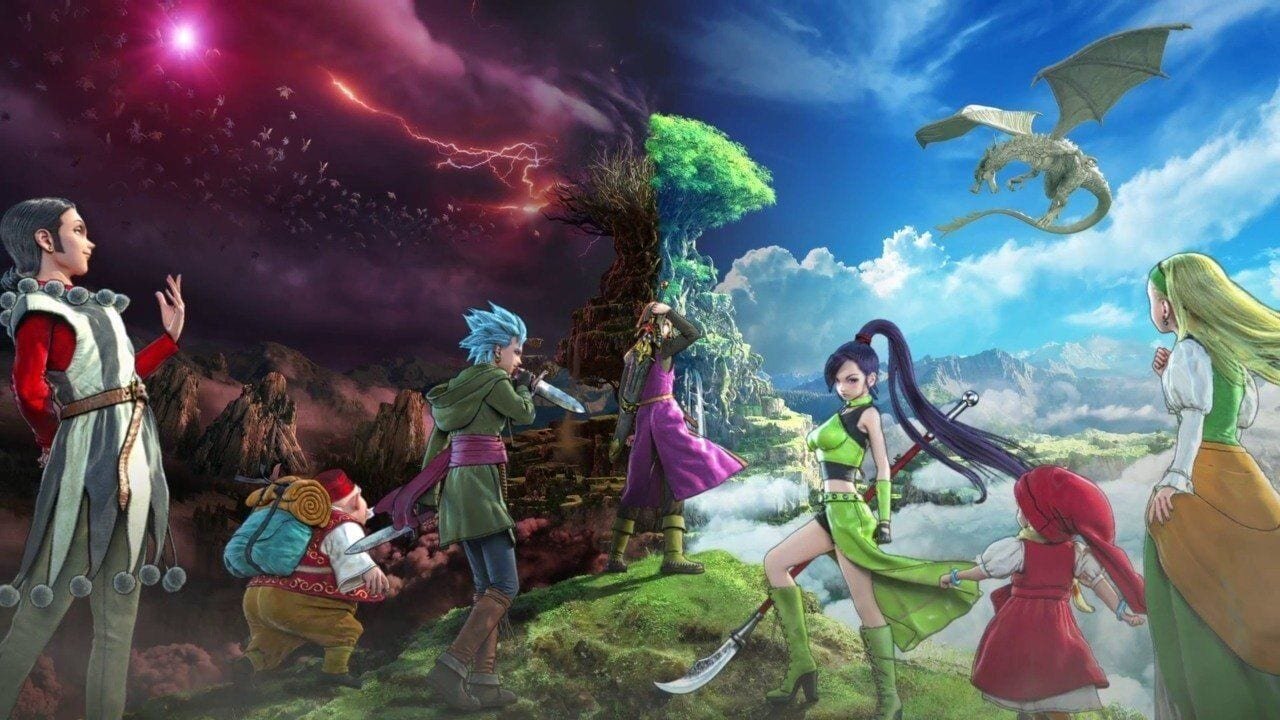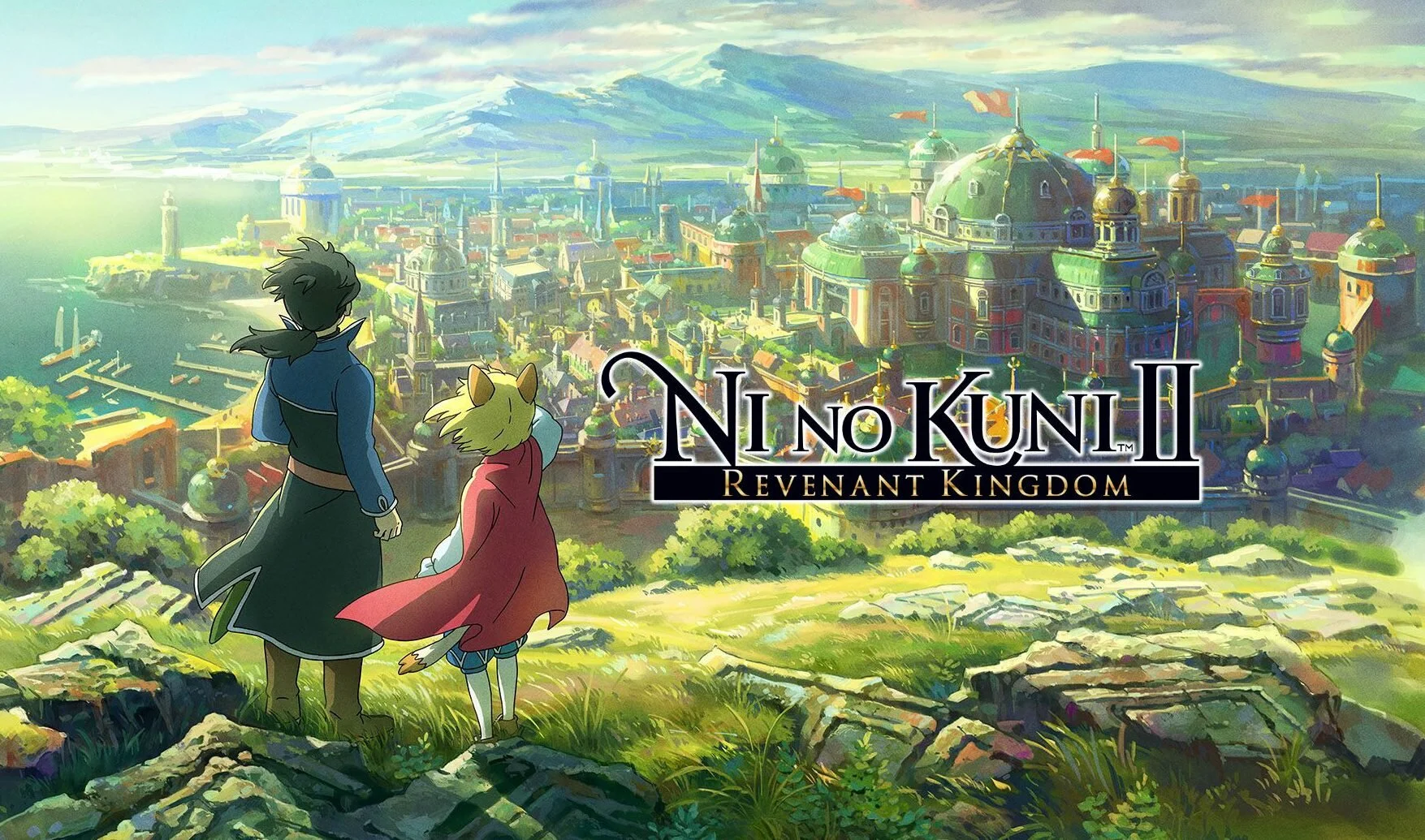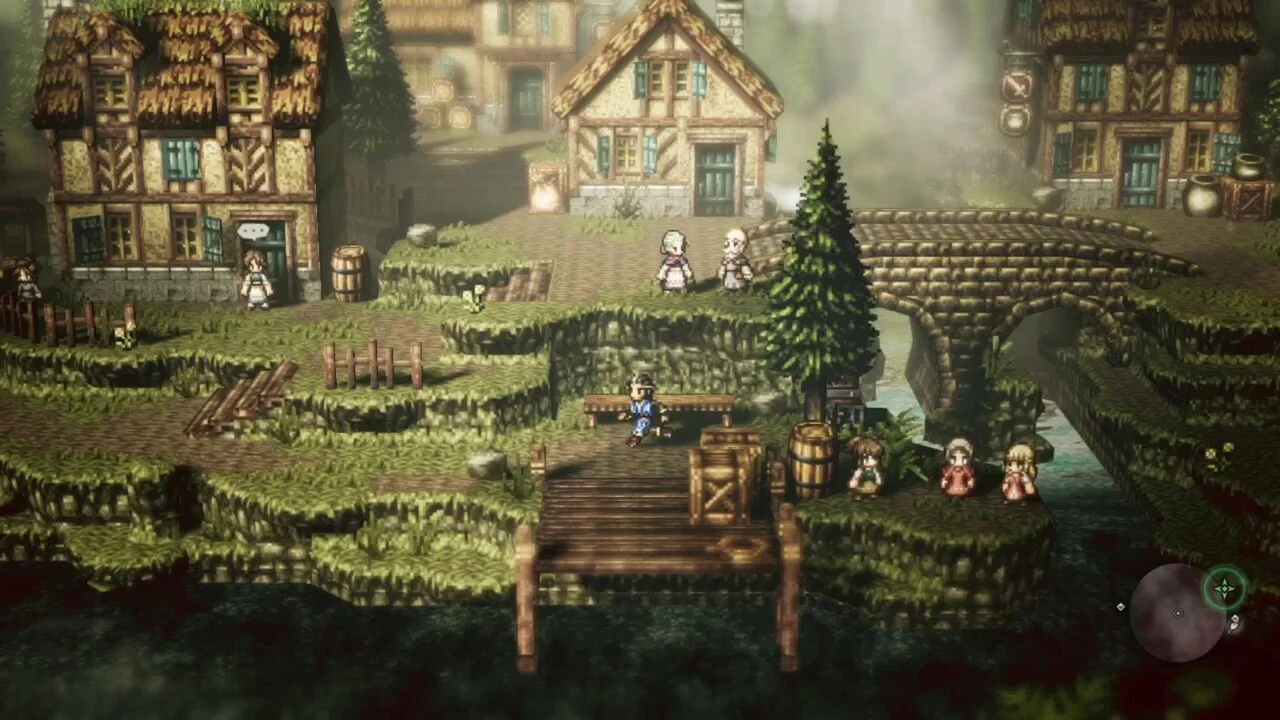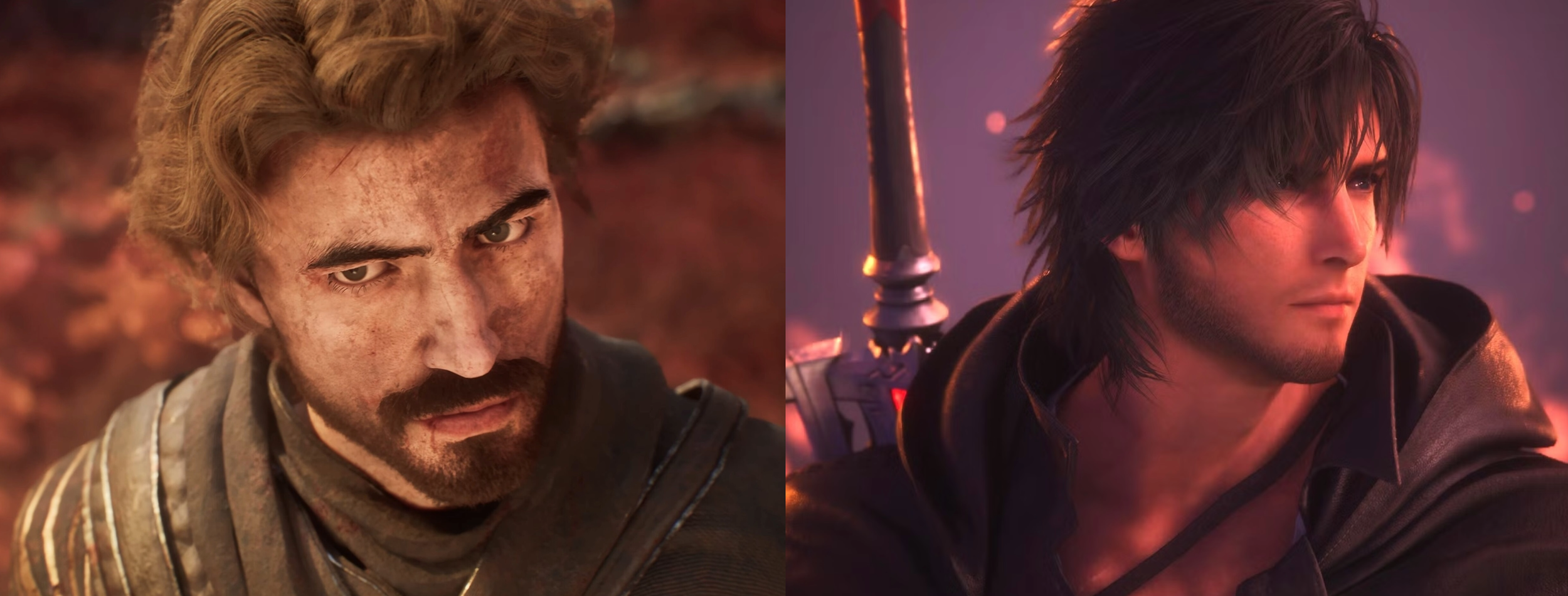5 Easily Accessible, Beginner Friendly, and Must-Play JRPGs for Genre Newcomers
Final Fantasy X, originally released in 2001, stands as one of the most well-constructed JRPGs of all time. This game is simple enough to be someone’s first RPG, but has enough depth and side content to challenge genre veterans. With FFX’s HD Remaster available on all modern platforms, Final Fantasy X is easily one of the best starting points for those looking to get into playing JRPGs. // Image: Square Enix
I’m not alone in claiming that Role Playing Games are easily my favorite genre of video games. More than any other type of game, RPGs focus on transporting players to other worlds, offering escapism and immersion unlike anything capable in any other medium. Some RPGs may focus on exploration, others more on combat or on role-playing with characters. No matter the individual game’s focus, RPGs tend to deliver special experiences that deeply resonate with players around the world.
There are so many different types of RPGs that cater to different tastes and different types of players. My personal favorite flavor of RPGs is doubtlessly the Japanese Role Playing Game or JRPG. Many fantastic Role Playing Games have come out of Japan, as far back as 1986’s groundbreaking Dragon Quest. Since then, JRPGs have often been defined by their approach to storytelling. It’s practically impossible to put the entire JRPG genre into a single definable box, as JRPGs are incredibly varied, especially as the genre began regaining popularity in the 2010s. Nevertheless, JRPGs have given me some of the most unforgettable and enjoyable experiences with video games I’ve ever had.
From someone on the outside looking in, it can seem absolutely daunting to get into JRPGs. There are so many different types of JRPGs, some action-based, others turn-based, and many JRPGs that have different specific specialties that they focus on. With all of that in mind, what are the best JRPGs to play for those most interested in trying out what the genre has to offer?
This list is going to approach answering that question through showcasing what I feel are easily accessible games that showcase some of the best of what the JRPG genre has to offer. The games I will be discussing are what I feel are easily accessible, beginner friendly, and must-play JRPGs that are perfect for genre newcomers to try out.
Before I begin this list proper, though, I feel that it’s necessary to define what criteria I’m using to assess a JRPG being easily accessible and beginner friendly. Firstly, platform availability is an important aspect. If you’re a genre newcomer, you likely have a limited number of platforms at your disposal. Maybe you only own one modern console or a decent PC. As such, the games I’ll be recommending here are available on multiple platforms to accommodate newcomers that don’t have various options. As such, JRPGs that are exclusive to certain consoles or platforms won’t be appearing here.
The next criteria that I’ve considered for this list is quality. Obviously, I want to recommend some of the best of what the JRPG genre has to offer, and so I feel that the following games are enjoyable experiences that are worth the time of those willing to play through them. I’ve also considered the length of these games. Role Playing Games across the board are notorious for often being very long games, and JRPGs are certainly no exception to this rule. Many JRPGs soar past being 100 hours long. That said, I realize that super long JRPGs don’t serve as the best possible samples for those looking to try out the genre for the first time. As such, the games I’ll be recommending here are between 20-50 hours (with one exception) - which is considered a more average length for RPGs. On a similar note, difficulty is another aspect that I’ve considered. These JRPGs may challenge in certain parts, but are generally not-so-difficult games to tackle if one only wants to play through the main story.
My next criteria for this list is intuitive, well-taught mechanics. I’ve taken the time to consider JRPGs that have easy-to-understand mechanics that are introduced and taught well to the player. That’s not to say that these are necessarily shallow games that don’t have much to understand. These games very much have deep mechanics that will challenge players, but the games here I feel do a great job at setting up the player for success through teaching their mechanics clearly and at a comfortable pace. My final criteria in genre representation. The JRPGs mentioned here are games that I feel represent the JRPG genre as a whole, showcasing the unique aspects of what JRPGs generally have to offer.
With these rules in mind, it’s finally time to get into the list proper. In order of release date, these are 5 games that I whole-heartedly recommend for JRPG newcomers!
Chrono Trigger
Originally released in 1995
Available on SNES, PlayStation, Nintendo DS, Android, iOS, and PC via Steam
Chrono Trigger, originally released in 1995, is often in the discussion for being one of the greatest video games ever made. Despite being over 25 years old, Chrono Trigger has aged tremendously well, thanks to its simple-yet-deep combat, timeless art style, and charming writing, music, and characters. This is a must-play for not only JRPG newcomers - it’s a must-play for any fan of Role Playing Games. // Image: Square Enix
It’s admittedly difficult to say much about Chrono Trigger that hasn’t been said before. For over 25 years, it has widely been considered to be one of the greatest video games ever made, both in and outside of RPG circles - and for good reason. As stated earlier, RPGs tend to be on the longer side, and as such, they can often stumble with pacing, and yet what makes Chrono Trigger so amazing is its practically perfect pacing. Despite only taking 15-20 hours to complete on a first playthrough - generally considered a below-average length for JRPGs -, the experience of playing Chrono Trigger is one that feels packed with things to do thanks to the game always knowing the perfect length for each of its sequences to be.
If the pacing of the game’s story won’t hook you, the story and world of Chrono Trigger absolutely will, as it has an ostensible charm unique from the rest of the RPG landscape, with the arguable exception being the game’s pseudo-sequel, Chrono Cross. While games before and since have tackled the concept of time travel, Chrono Trigger stands out from setting dire stakes fairly early on, constantly incentivizing the player towards their next goal. Especially considering Chrono Trigger came from an era where many RPGs still struggled to consistently and effectively convey what players needed to do to progress, playing through Chrono Trigger feels distinctly modern. A game that was remarkably ahead of its time, Chrono Trigger’s approach to its storytelling, worldbuilding, and character dialogue all feel incredibly well-realized and engaging from start to finish. Regardless if you’re investing in the JRPG genre in the long term, you owe it to yourself to at least play through Chrono Trigger, if only for its significance in the history of not only RPGs, but video games as a whole.
You also have this game to thank for popularizing the concept of New Game+, allowing players to start a new save file with their previously acquired progression and gear carrying over. In addition, this game was one of the few games of this era to implement multiple different endings. While this isn’t the first JRPG to do this, it’s certainly the first to implement so many vastly different endings in a way that feels natural given the circumstances of how one can finish the game’s story.
Another reason why the game is easy to recommend regardless if people are interested in significantly investing themselves into JRPGs is that Chrono Trigger’s main gameplay mechanic, its combat, is generally straightforward and intuitive to understand. Players will progress via a standard level up system from gaining experience from fighting enemies, while also learning new Tech abilities throughout the game, which can either be used individually or as special Techs that combine the Tech abilities of two or three party members. Additionally, Chrono Trigger implements area-of-effect attacks and the ability to begin enemy encounters through approaching enemies visible on the field - both of which were fairly uncommon mechanics at the time of Trigger’s original release but are now able to be seen as early modernizations of the JRPG genre.
Of course, the greatest aspect of Chrono Trigger is witnessing the game’s admirable, imaginative world. Chrono Trigger represents some of the very best of what the genre has to offer because it nails the comfy feeling of going on an adventure with a group of friends while battling against formidable stakes. Perhaps it’s a bit of a safe choice for a recommendation, but simply put, there’s a reason why this game is still talked about in such high regard. Few JRPGs, or games in general for that matter, match the quality and conciseness of Chrono Trigger’s narrative, and its combat, dungeons, and mechanics are simple to understand, yet fun and rewarding to explore and master. Simply put, Chrono Trigger very much deserves its place as one of the greatest games ever made - and it also deserves to be played by anyone curious to know what JRPGs bring to the table.
Chrono Trigger’s port to mobile and PC both serve as the definitive way to play the game, as they incorporate elements introduced in the Nintendo DS remake that included new endings that more directly connect Chrono Trigger to Chrono Cross. Regardless of the version chosen, the experience of Chrono Trigger is well-retained in all available versions of the game.
Final Fantasy X HD Remaster
Originally Released in 2001, HD Remaster Released in 2013
Available on PlayStation 2, HD Remaster Available on PlayStation 3, PlayStation Vita, PlayStation 4, PC via Steam, Nintendo Switch, and Xbox One
The Final Fantasy franchise is full of entries that are great starting points for JRPG newcomers, though I would argue Final Fantasy X is the best starting point of them all. With a well-paced story, a great cast of characters, a simple-to-understand yet deep combat and progression system, and a fascinating world, Final Fantasy X does a phenomenal job at capturing the imagination of players, exemplifying some of the best worldbuilding seen in any JRPG. // Image: Square Enix
Many JRPG fans likely had their journey with the genre begin with the Final Fantasy franchise. And for good reason - the series is full of high-quality RPGs that capture the imagination, wonder, and addicting, rewarding gameplay that define the unique experiences that JRPGs provide. While some entries are better than others, Final Fantasy is a series that’s easy to recommend to genre newcomers and veterans alike.
For newcomers that may be unaware, each mainline and spin-off Final Fantasy game is standalone, so don’t let the numbers in each of the games’ titles scare you away. While there a few sequels (such as Final Fantasy X-2 and the Final Fantasy XIII trilogy), most of the series’ entries require no familiarity with other entries and are self-contained stories. Square Enix has often approached Final Fantasy to be an RPG franchise that’s beginner friendly. Because of that, the Final Fantasy series is full of great starting points for genre newcomers. With that said, if I were to choose a single entry from this series that best represents both this franchise and the JRPG genre as a whole, I would choose Final Fantasy X without hesitation.
Why this game in particular? Like with Chrono Trigger, Final Fantasy X has some of the best pacing in the entire genre, with a story-only playthrough clocking in at 25-30 hours. While there is a great variety of side content that can easily bump that up to over 100 hours (especially in the HD Remaster, which includes content introduced in the International Version that originally never came to North America), those who just want to see the main story unfold will be met with one of the most emotional, well-paced, and well-realized stories in any JRPG. Moreover, the tone, themes, and overall vibe of Final Fantasy X represents ideas and aesthetics that feel profound and fresh, even after 20 years since its release. Additionally, it’s just a fun game from start to finish.
Final Fantasy X was a leap forward for the series and a genre as a whole at the time of its release. It was the first Final Fantasy game to incorporate voice acting, detailed facial animations, and even more visually impressive CG animated scenes that still look great today. Despite some occasional voice acting oddities in the English dub, Final Fantasy X has aged remarkably well and can easily be enjoyed by anyone. The HD Remaster available on all modern platforms only further highlights the game’s impressive art direction, and a rerecorded soundtrack that stands as one of the best soundtracks in the medium. Moreover, the game carries a unique aesthetic of a fantasy world based on Southeast Asia - an incredibly distinct setting choice that hasn’t been explored much in games before and since this game’s release.
What makes Final Fantasy X so worth recommending to genre newcomers beyond its great pacing, story, setting, and production value is, once again, its combat and mechanics. Final Fantasy X definitely has more mechanics to take into account than Chrono Trigger, and as such, Final Fantasy X implements various tutorials to help players understand the game’s mechanics and its unconventional progression system - all at a pace that I feel is just right so that it never feels boring or overwhelming to new players. Indeed, Final Fantasy X’s progression system isn’t tied to a traditional system where characters level up over time. Rather, players navigate a Sphere Grid to develop characters’ stats and abilities (which in the HD Remaster, can either have more linear, guided character progression or non-linear, more customizable character progression). Additionally, players can customize weapons and armor to give characters unique attributes and abilities. Both the Sphere Grid and equipment customization systems leave a lot for unique player expression through character growth.
Contrasting the game’s more unconventional yet effective progression system is the game’s fairly traditional combat. Final Fantasy X is one of the few games in the Final Fantasy series to use an entirely turn-based system, in which the player can always view the turn order and can strategize their attacks accordingly. Exploiting enemy weaknesses via spells, afflicting status ailments to temporarily weaken enemies, and consistently learning new abilities to use in battle are genre staples that are very well implemented here. However, Final Fantasy X also implements many new elements that help the game feel distinct from other JRPGS and other Final Fantasy games. Namely, players can switch out character mid-battle, directly control summonable Aeons, and unleash Overdrives that implement timing minigames unique to each character. While the quantity of these mechanics might seem daunting on paper to newcomers, each mechanic gets its own proper explanation and demonstration to the player, effectively teaching players its many mechanics. In time, genre newcomers will effortlessly find themselves understanding all of the game’s mechanical systems within the first five hours of play.
With its amazing implementation of tutorials that don’t overstay their welcome, Final Fantasy X is able to ensure that players understand its mechanics while being fully immersed and engaged in its unique world and story that has captivated millions of players for over 20 years. Final Fantasy X is often regarded as the best entry in the series and one of the greatest RPGs ever made, and I personally feel that the many points of praise the game has received over the years are definitely well deserved. It’s one of the most essential RPGs to play and is an easy recommendation to RPG veterans and newcomers alike.
Luckily, Final Fantasy X is one of the most accessible JRPGs to date, with the HD Remaster being available on all modern consoles and PC. While the original PlayStation 2 version holds up well, the HD Remaster includes a lot of new content that increases replay value significantly. While the facial animations are not quite as polished as they were in the original release, I would argue that the HD remaster for the most part looks and sounds incredibly well and stands as the definitive way to play this game. The HD Remaster of Final Fantasy X is easy to come across and well worth taking the time to play through.
Dragon Quest XI S: Echoes of an Elusive Age - Definitive Edition
Originally Released in 2017. Definitive Edition Released in 2019
Available on Nintendo Switch, Xbox One (including Xbox Game Pass), PlayStation 4, PC via Steam, and Stadia
The Dragon Quest series perhaps showcases the entire JRPG genre the best out of any series in part to it essentially kickstarting the genre. For better or for worse, the series generally takes an iterative approach, with each new entry playing relatively similarly to each other. That said, Dragon Quest XI is easily the best the franchise has to offer, and is available on all modern platforms. It’s simple yet rewarding gameplay and gripping world and story make it an easy recommendation. // Image: Square Enix
Any JRPG fan or newcomer owes it to themselves to try out a Dragon Quest title. The series has historically been massive in Japan yet has struggled to gain a significant following internationally. Though, that narrative has slowly begun to shift over the last decade. The remakes of Dragon Quest VII and VIII on Nintendo 3DS helped introduce the series to a new generation of JRPG fans, though the release of Dragon Quest XI very well may have brought the biggest influx of new fans of the series in the West yet. While the initial release of Dragon Quest XI garnered a positive reception, many lamented the inclusion of a less-than-stellar MIDI, synthesized soundtrack.
In 2019, though, the game received a Definitive Edition that first released on Nintendo Switch that has since been ported to other platforms mentioned above. This Definitive Edition includes a fully orchestrated soundtrack - a substantial upgrade from the synthesized tracks (which are still available in the game via a toggle in the game’s settings). Beyond the inclusion of an amazing orchestrated soundtrack, Definitive Edition also includes a 2D mode that allows the whole game to take the form of a SNES-style game, great pixel art and random encounters included. Lastly, there are new story segments that are integrated so seamlessly, a new player will be hard-pressed to distinguish what was and wasn’t in the original game’s release.
All this is to say that Dragon Quest XI S: Definitive Edition lives up to its namesake - it’s easily the best way to play the game, and barring any remaining physical copies of the original version of Dragon Quest XI, it’s the only way to purchase the game now anyway. Clearly, this game is accessible simply from being available on so many platforms, but what makes Dragon Quest XI S such a great JRPG starting point is how well put together and easy-to-understand the game is.
Like with Final Fantasy, Dragon Quest titles are primarily self-contained from one another. While some titles are loosely connected to one another, the stories contained within are all self-contained and don’t require playing through other entries. Unlike Final Fantasy, Dragon Quest typically doesn’t reinvent itself every entry - rather, each entry refines a formula while making modest touches, improvements, and introducing minor title-specific mechanics along the way. Dragon Quest XI doesn’t break this tradition, as it’s not too different from other Dragon Quest entries, gameplay-wise. The game uses turn-based combat that’s relatively straightforward, though the inclusion of the “Pep Up” system spices up combat enough to keep battles consistently exciting. Being Pepped Up opens the door to essentially use attacks where multiple party members team up, in addition to other perks. Outside of that, the game’s combat uses typical attacking and spellcasting fare - all of which are mechanically taught to the player pretty well.
Dragon Quest XI uses a typical level up system with a skill tree system to learn new abilities and spells. The combat in Dragon Quest XI is solid and will easily keep players invested. Though, the real strength of Dragon Quest XI is its insanely well-realized world, characters, and story. More so than any other mainline Dragon Quest title, XI makes a significant effort to flesh out each of its eight playable characters through significant plot beats. Moreover, the worldbuilding and character writing is incredibly impressive - delivering a level of charm and immersion that feels incredibly unique to this world. There are various setpieces such as towns in which all of its citizens speak in haikus that help create an endearing setting that will make players wish that they never have to leave it. While its combat systems are simple to understand and offer a solid gameplay experience that’s great for beginners, the real reason JRPG newcomers should try out Dragon Quest XI is to see its excellent world and characters on display. It’s truly some of the best that the genre has to offer.
Thanks to Dragon Quest XI S being available on just about everything, the game is incredibly easy to access. The game is the previously mentioned exception to this list’s “length” rule - Dragon Quest XI S will easily take over 80 hours to complete. It’s definitely above average in terms of length, but the adventure contained within Dragon Quest XI S is too good to dismiss for its length. The Dragon Quest series is an important pillar of the JRPG genre, and Dragon Quest XI S is easily one of the best representations of its series and the JRPG genre as a whole.
Ni no Kuni II: Revenant Kingdom
Originally released in 2018
Available on PlayStation 4 and PC via Steam
The Ni no Kuni series deserves significantly more attention in my eyes. While there are only two games in the series, both offer incredibly enjoyable and unique experiences that deserve to be played by any fan of Fantasy RPGs. Ni no Kuni II: Revenant Kingdom takes a more traditional Action-RPG approach to its combat, yet its simple-to-understand mechanics, addicting questing system, and rewarding town-building features make it something I can recommend to JRPG newcomers and veterans alike. // Image: Bandai Namco
I realize that this list is dominated by games published by Square Enix, so I feel the need to diversify for at least one entry on this list. Thankfully, Level 5 and Bandai Namco’s Ni no Kuni series is yet another JRPG franchise that, while currently only having two entries, delivers some of the most enjoyable and immersive JRPG experiences I’ve ever had. The series has a Studio Ghibli-inspired art style (with the legendary studio even animating a couple cutscenes in the series’ first entry), and each Ni no Kuni game creates worlds that are visually striking, imaginative, and whimsical. Each game plays differently, with Ni no Kuni: Wrath of the White Witch playing like a Pokemon-esque monster collecting Action-RPG where players primarily control collectable monsters, while Ni no Kuni II: Revenant Kingdom plays like a more traditional Action-RPG where players control humanoid party members. While there are still monsters (named Higgledys) to collect in Ni no Kuni II, they play a more supportive and passive role during combat, rather than being directly controlled.
While both games are fantastic JRPGs, I feel that Ni no Kuni II: Revenant Kingdom has a combat system that’s generally easier to grasp for genre newcomers. Moreover, I feel that Ni no Kuni II offers a great introduction to the concept of town-building - something that’s featured in plenty of JRPGs. Indeed, Ni no Kuni II emphasizes building a new kingdom through completing side quests, collecting materials, and completing Skirmish battles, which are a Strategy RPG-esque minigame that offer a pleasant change of pace from the game’s more typical Action-based battles. Ni no Kuni II will see players turn a small camp into a sprawling kingdom - something that feels remarkably satisfying to see unfold over the course of the player’s adventure.
Though, there’s more to Ni no Kuni II’s world and story than just building a town. There are various towns, continents, and dungeons to visit in Ni no Kuni II and practically all of them have an ostensible charm that will keep players sucked into this world. Moreover, the game features very snappy Action-based combat that teaches its mechanics at a pace that will be very comfortable for genre newcomers. One of Ni no Kuni II’s greatest strength, like with other entries on this list, is its fantastic writing evident in dialogue. The degree of character expression and worldbuilding when talking to NPCs and other party members creates the feeling of an adventure unlike anything else in the JRPG landscape. The game also features a questing system to get more and more residents to join the kingdom that the player is building throughout the game - highly rewarding talking to various NPCs and resolving the issues that they face.
Simply put, Ni no Kuni II is a cozy game that does a phenomenal job at creating a world that the player wants to help improve through building up a new, prosperous kingdom. Its imaginative world, fantastic writing, and easy-to-understand and satisfying combat make Ni no Kuni II one of the most enjoyable and tragically underappreciated JRPGs in recent memory.
The game is only available on PlayStation 4 (and PlayStation 5 via backwards compatibility) and PC as of writing, making it on the least number of platforms out of any entry here. However, I feel that Ni no Kuni II serves as one of the best introductions to JRPGs that put a greater emphasis on completing side quests, town-building, and have a more Action-focused approach to combat. It’s a JRPG that deserves to be played and appreciated by more people, and I feel that it’s a wonderful starting point for JRPG newecomers.
Octopath Traveler
Originally released in 2018
Available on Nintendo Switch, PC via Steam, Stadia, and Xbox One (Including Xbox Game Pass)
Octopath Traveler is one of the most visually striking games ever made. It uses a beautifully-realized 16-bit/diorama art style that pops, giving the game an immediately recognizable identity. Beyond that, Octopath’s world, writing, and characters deliver some of the best that the JRPG genre has produced this decade. Its deep combat system is introduced at a comfortable pace for new players. By the time they have a full party, newcomers will easily grasp the complex intricacies of Octopath’s combat. // Image: Square Enix
While I’ve talked about my grievances with this game’s approach to main party character interactions in the past, I still walked away from Octopath Traveler very much enjoying the game. As the years have gone on, I look back on my experience with Octopath Traveler very fondly, and in hindsight, I feel that it delivers some of the most interesting worldbuilding and combat I’ve seen in any RPG for a long time. Octopath Traveler foregoes telling a story involving all of its eight playable characters and instead focuses on telling eight smaller stories focusing on each individual character. It’s an approach that won’t connect with everyone as it can make party members feel a bit disconnected from one another, but the stories that are actually told here are quite investing and enjoyable. Moreover, the various different towns, dungeons, and environments that the player will navigate on their journey in this game’s world are striking and incredibly memorable.
Equally memorable is the game’s amazing presentation. Whether it’s the fantastic worldbuilding present in the writing, solid voice acting, incredible soundtrack, or the vividly striking art style, there’s a lot to like about the way Octopath presents its world, story, and characters. The world and stories presented in Octopath Traveler manage to capture an amazing sense of adventure that draws so many people to RPGs in the first place.
Of course, the best aspect of Octopath Traveler is its robust combat system. Octopath implements a turn-based combat system, which, while becoming less common in the modern RPG landscape, manages to offer some of the best turn-based strategy seen in recent memory. The game will require players to exploit enemy weaknesses through using different weapon and magic types, which will gradually cause a “Break” on an enemy, making them vulnerable to massive damage. Additionally, Octopath allows players to stock up on actions (similar to Bravely Default), so that players can dish out multiple attacks in a single turn. This allows players to strategize if they want to spend multiple actions to hit enemy’s weaknesses to inflict “Break” sooner, or save their multiple actions for when the enemy is already in the “Break” state, so that they can use all their stored turns to inflict incredible amounts of damage.
Needless to say, there’s a lot of strategy to be found in Octopath’s combat system, and over time, the inclusion of the ability to mix and match job types only increases the level of strategy on display. While there are a lot of aspects of Octopath’s combat, it’s all introduced and taught to the player at a comfortable pace, and serves as an excellent way for players who are looking for JRPGs that require diligent use of strategy. While the game starts out easy to accommodate for players learning the game’s systems, Octopath ramps up the difficulty over time and offers exhilarating battles that necessitate strong strategy, making for satisfying and intense battles.
Octopath’s combat presents more challenge than other games on this list, though I feel that it’s a perfect JRPG for those looking for combat systems that have a bit more meat to them. Not to say that the other games featured on this list don’t have their own complexities, but I feel that Octopath offers some of the most combat possibilities to consider out of the game’s I’ve recommended here. I wholeheartedly recommend Octopath for JRPG beginners that are looking for a game that has a combat system that will eventually test them. I’m comfortable recommending this to genre beginners given how well the game introduces its systems to players before ramping up the degree of strategy require to win fights.
Beyond its strategic and rewarding combat, Octopath Traveler delivers one of the most interesting and fun-to-explore worlds in all of JRPGs, making it a game well worth playing for anyone interested in the JRPG genre. With the game available on so many platforms now, it’s incredibly easy to jump in and see what this game brings to the table.
As someone that truly loves the JRPG genre, I could go on and on about recommendations. While the five games listed above are great, accessible starting points for those interested in getting into the genre, there’s so much more to explore within the genre. As such, I’ll offer some additional newcomer recommendations here that are either not-as-accessible or are games I’d recommend after having a few JRPGs under one’s belt.
Needless to say, any mainline Pokemon RPG will suffice as a solid starting point for JRPGs. The reason I didn’t include any Pokemon title in this list is because, not only are all mainline Pokemon games only available on Nintendo hardware, I don’t feel that they offer the best worlds or gameplay systems that the JRPG genre can possibly provide. They’re solid games in their own right, though I don’t feel that Pokemon necessarily represents the JRPG genre as a whole very effectively. Additionally, most Pokemon RPGs generally follow the same format, so any game within the main series will work as a good enough entry point for JRPGs. As such, I don’t really feel like there’s a particular entry in the series that genre newcomers need to play before any other JRPG.
While Final Fantasy and Dragon Quest are two JRPG franchise titans that I can easily recommend here, one of my favorite JRPG series, the Shin Megami Tensei franchise, is unfortunately not as easy to recommend to genre newcomers, as they’re more complex and very distinct from most other JRPGs. That said, Persona 5 Royal is the probably the only entry in the entire Shin Megami Tensei universe that I can comfortably recommend to newcomers. While the game is very long and is currently excusive to PlayStation 4, its story, characters, and combat have all garnered nearly unanimous praise for good reason. It’s a commitment and it’s not available on multiple platforms, but it’s a great starting point for those that are willing to make the investment.
Lastly, this wouldn’t be a JRPG-related piece by me if I didn’t find some way to shoehorn in a mention of the Xenoblade Chronicles series. While there are currently three entries in the series (four if you want to count Torna: The Golden Country separately from Xenoblade Chronicles 2), I feel that the series has quickly become one of the greatest and most important JRPG franchises. That said, Xenoblade Chronicles: Definitive Edition is a truly fantastic JRPG that I would recommend to genre newcomers that have at least one JRPG under their belt and are looking for something that encourages exploration and offers combat that’s more complex. I’m definitely not recommending it as a first JRPG, but I think it’s well worth looking into the series if one has played through and enjoyed at least one JRPG. While Xenoblade Chronicles has been previously available on Wii, Wii U, and Nintendo 3DS, the Nintendo Switch remaster lives up to its namesake as the definitive way to play the game.
I’ll be refraining from going into any further recommendations, as I could truly go on for thousands and thousands of words. Perhaps I’ll look into five additional recommendations in the future.
The JRPG genre is not as hard to get into as some may think. The games discussed here are proof that the genre is capable of being welcoming to newcomers. Regardless of which JRPG you start with, know that the genre is beloved for a reason. They transport players to other worlds to explore, offer various characters to talk to, and deliver gameplay experiences that can be strategic, stylish, and satisfying. It’s a great time to be a JRPG fan, and it’s just as great a time to become a JRPG fan.
Thank you very much for reading! What do you think are JRPGs worth recommending to beginners? Feel free to chime in and join the conversation in the comments or on Twitter @DerekExMachina.

